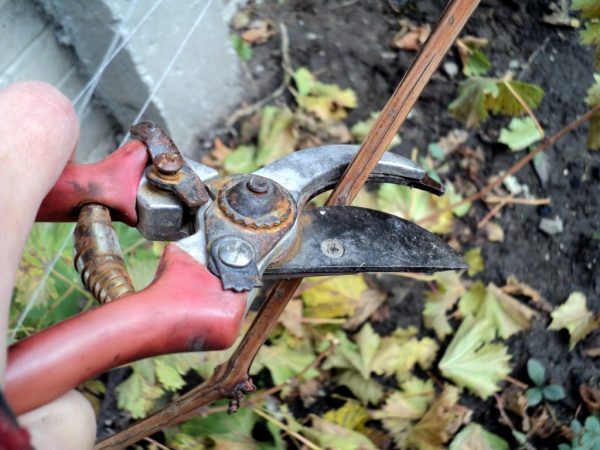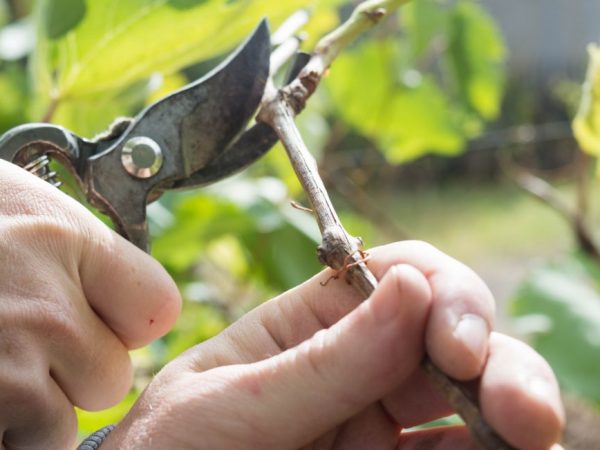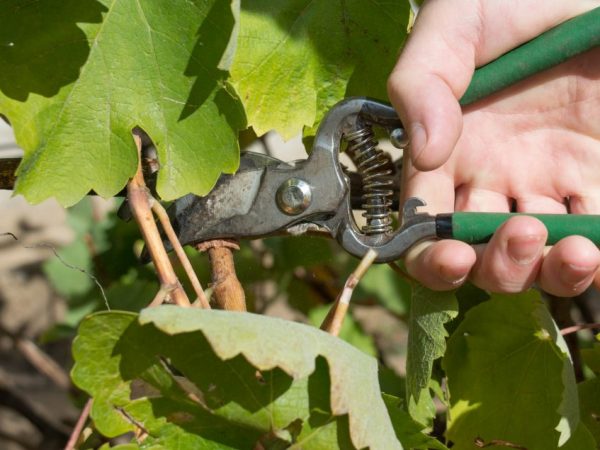Autumn pruning of grapes
Autumn is the period of preparation of the vineyard for winter. Bushes get rid of leaves, sap flow stops. Pruning grapes in the fall is a way to prepare a crop for wintering and positively affect its yield next year.

Autumn pruning of grapes
Rules for pruning grapes
The autumn molding of the grape crop is carried out after the leaves have fallen off. In the first year, only the top is cut off or the plant is not touched at all. In the first year, the plant is still weak, it needs to gain strength for active growth and building up green mass.
In all subsequent years, the grower will have to deal with shaping both in the fall and in the spring. The need for the procedure is associated with the removal of old dead branches that have not survived wintering.
It is important to monitor the clear formation of the vines. Any mistakes will affect crop yields and health. Due to the influence of some unfavorable factors, plants are not able to survive the winter.
Advantages and disadvantages of the procedure
Pruning grapes in autumn has both positive and negative consequences. Among the advantages of the various methods used in the fall, the most significant is the facilitation of wintering. Correct pruning contributes to the compactness of the vineyard - it will be easier to cover.
There are other benefits to pruning at the end of the sap flow. The most useful for beginners are:
- fast healing of slices;
- stimulation of early bud opening in spring;
- acceleration of the ripening of the crop, which is important for regions with cold climates.
Among the disadvantages, the possibility of freezing of the cut points is especially prominent. Such consequences arise if pruning is carried out at a later time: at the end of October-November. Among the consequences of this phenomenon, the drying of thin shoots (annuals) and the late formation of buds are noted, which affects the abundance of the crop, its quality and the time of harvest.
Favorable time for pruning
In total, there are 2 stages of correct pruning. The first time it is produced in September: the remnants of yellowed leaves and dried branches are removed; - and the second - in October, when the sleeves are given the necessary shape. Often the timing of the 2nd stage of the operation depends on the end of the leaf fall. It is carried out 2 weeks after.
During the second, formative pruning, the weather conditions are monitored. Favorable air temperature for work in the vineyard should be at least 10 ° C in the absence of wind and precipitation.
All operations for the non-covering bush are completed several weeks before frost. For covering varieties, winter coolness is not a hindrance. Some growers prune and cover the plant after the first frost. The main thing is that while working in the vineyard, the air temperature does not fall below 5 ° C.If the temperature is below this limit, the vine breaks when bending towards the soil.
Pruning schemes

In the first year, only the top needs to be cut
There are several schemes for the formation of bushes of grape culture, starting from the first year after planting seedlings. In the first year, the procedure is the easiest. Only the top of the plant needs to be cut.
Subsequent years of crop cultivation may differ in the abundance of different types of formation of spreading bushes. The most popular among winegrowers are the following formations:
- fan;
- bowl-shaped;
- standard;
- cordon.
For beginners to grow grape culture, you should choose simpler formation options: fan and standard. Each of them has its own characteristics.
Fan scheme
This formation is performed in several stages. In the third year of the plant's life, the main vine and the shoot obtained from the replacement knot are shortened by half. The next fall, the grapes grown are pruned for the winter as the sleeves are formed. External should be larger than internal.
The final formation of the fan is carried out by removing a part of all young processes. Only 2-3 uppermost shoots are left. They will be fruitful. They are tied to a trellis.
The upper vines are pinched on the 7-8 eyes, and the lower ones - on the 2-3 buds. The subsequent seasonal renewal of the fan consists of removing all fertile branches. Then they will be replaced by annual vines.
Stamp scheme
The standard type of bush formation is carried out already in the 2nd year after planting the seedling. Identify the 2 most powerful shoots. The larger one will be the stem, and the second one will be the reserve shoot. The main stem is pinched at the apical part.
In the 3rd year, the stems left are shortened: the main one - up to 6 buds (it will be fruitful), and the reserve one - by 2 eyes (replacement knot). In the following autumn, 90% of the shoots on the shoulders are removed. Only the strongest of them are left. These will be fruit-bearing branches. All subsequent moldings are directed to the removal of fruiting branches.
Formation of a bush of young grapes
Pruning young grapes for winter is different from the procedure for a perennial bush. All operating schemes used should be aimed at obtaining a healthy and vigorous bush.
Correct pruning has the following goals:
- the formation of sleeves;
- stimulation of vine growth;
- getting a good harvest in the future.
You will have to prune grapes for the winter in 3 different ways in the first 3 years after planting the seedling. Starting from the age of three, sanitary and formative pruning is performed according to the same scheme.
Sapling pruning

Formation allows you to accelerate fruiting
Young grapes, 1 year old, are simply pruned. Only the top of the vine is removed. 2-4 buds should remain on the seedling. The cut is 1 cm higher than the last eye. This version of the procedure for an annual bush will create conditions for the formation of sleeves for 2 years of plant life.
Operations performed on a one-year-old seedling lead to the formation of a replacement knot. For its final formation, the young process is cut into 2 eyes. At the first shoot (last year), 4-5 eyes are left.
The plant, which is already 3 years old, creates a fruitful shoot. The replacement knot is already below the main shoot. It will have to be cut into 3 eyes. The rest of the shoot should have 5-10 buds. Performing such an operation will allow you to create 4-6 sleeves prone to fruiting.
If you follow the rules for pruning one-year and two-year grapes, as well as the formation of sleeves at an older age, the first harvest from a planted crop can be obtained in just 4-5 years.
How to prune a gazebo bush
In regions with a temperate climate, frost-resistant, non-covering grape varieties are very popular among winegrowers. They are successfully grown on an arch or a gazebo.Growing up, such grapes acquire a spreading shape, while the length of the shoots exceeds 4 m. To cut such grapes, you will have to decide on the best procedure for the procedure. Pruning is suitable for an arbor plant:
- semi-covering;
- cordon;
- cordon with 1 shoulder;
- fan.
The most popular was the semi-covering shaping. With this procedure, vines are removed from the sleeve, which are placed on the upper wire of the trellis or arch. Unlike the first sleeve, the spare is placed on the lower trellis (its length is the same).
1 sprouting shoot remains at the bottom. It is shortened every fall. In regions with cool climatic conditions, the shoots are covered with the lower sleeve. The correct procedure allows you to get good growth of a new shoot in the summer, which, with subsequent pruning, actively grows and bears fruit.
How to prune running grapes
To prune overgrown grapes for the winter, all old dry branches are removed first. The condition of the vineyard is determined using incisions. If the vine is green inside, it is left: it is healthy. The branches, on which the cut is dark and dry, are removed.
The old bush is reanimated in October. This month, the weather is good for gardening outside, and the plant is easy to prepare for winter.
The second stage of pruning an adult neglected vineyard involves the formation of a bush:
- shoots are left to winter, on which there are 10-12 buds, and their thickness is at least 5 cm;
- more than 80% of annual shoots are removed;
- the remaining shoots are evenly distributed on the trellis.
Before performing such work at the end of September, the remaining leaves and stepsons are removed from the grapes that have been started. Correct formation allows you to improve the quality of fruiting by the next season, but the yield of the crop can temporarily deteriorate.
Cropped crop care
After pruning the grapes in the fall, the culture is properly cared for. Before the onset of cold weather, the soil is produced and loosened to organize the access of oxygen to the roots of the plant.
Another important rule is to apply fertilizer before wintering. Rotted manure or humus will do. Saplings up to 3 years old are covered with pine branches, sawdust or hay. Oilcloth is needed to create a greenhouse effect.
Conclusion
In order for the grape culture to grow actively, it is necessary to prune the grapes in the fall as early as 1 year after planting. For the next year, they are determined with the desired scheme for shaping the bush. Fan and standard types are easier for beginners. With the correct fulfillment of all the requirements of forming the culture, the grower gets the desired harvest in just 3-4 years.


